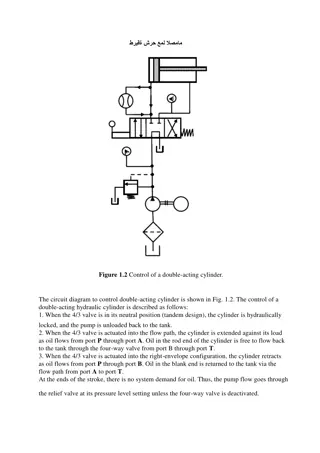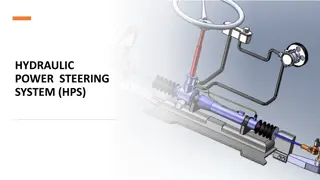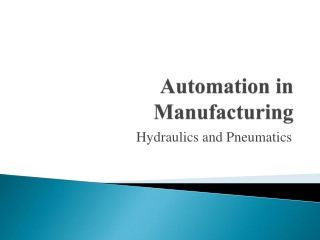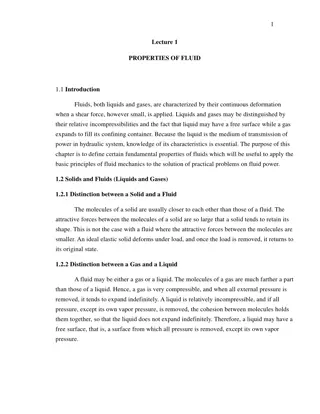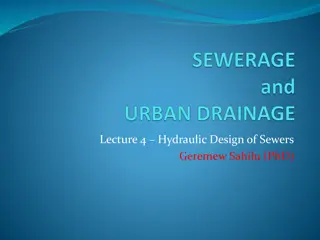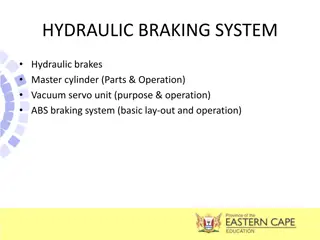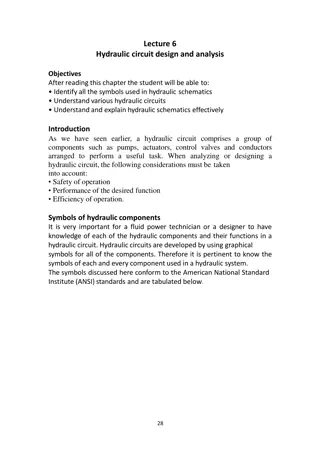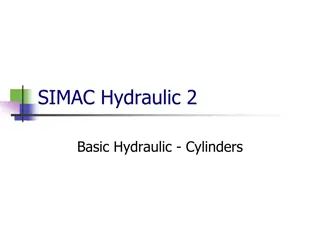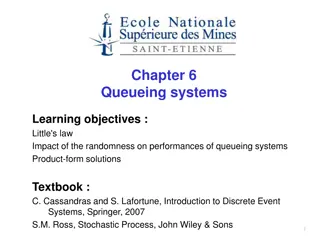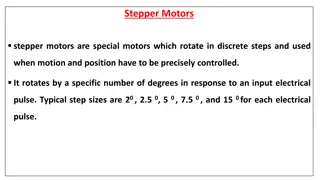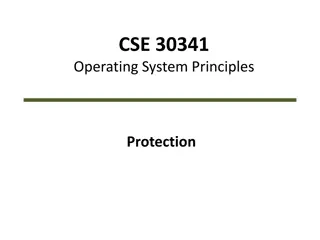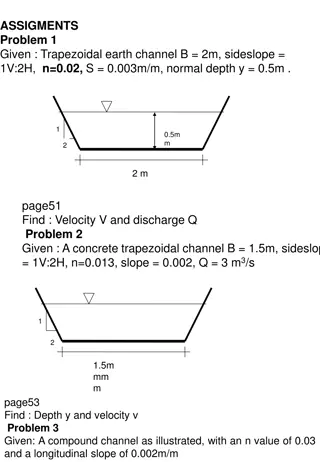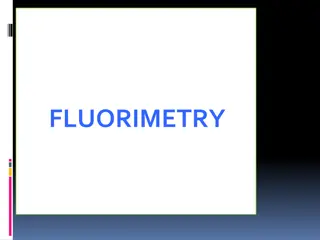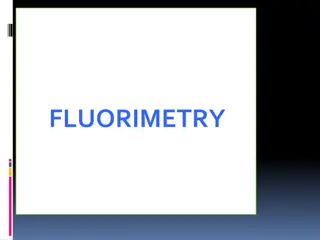Introduction to Hydraulic Systems: Principles and Applications
Hydraulic systems utilize enclosed fluid to generate controlled motion and force, based on Pascal's law. The system components include a storage tank, hydraulic pump, pressure regulator, control valve, cylinder, and piston. Through these components, hydraulic systems provide precise control over larger forces, making them essential in various industries and applications such as industrial machinery, mobile equipment, and robotic systems.
Download Presentation

Please find below an Image/Link to download the presentation.
The content on the website is provided AS IS for your information and personal use only. It may not be sold, licensed, or shared on other websites without obtaining consent from the author. Download presentation by click this link. If you encounter any issues during the download, it is possible that the publisher has removed the file from their server.
E N D
Presentation Transcript
Hydraulic Systems Lecture 1 Introduction 1. Introduction 1. Meaning of Hydraulic The Greek word 'Hydra' refers to water while 'Aulos' means pipes. The word hydraulics originated from Greek by combining these words, which in simple English means, water in pipes. The principles of hydraulics were put to use water energy in converting the energy of flowing water into useful mechanical energy by means of a water wheel. Nowadays, the meaning has been expanded to include the physical behaviorof all liquids,includinghydraulic fluid. 2. Types of energytransformer Electrical machines or diesel, petrol and steam engines are prime movers. These prime movers can provide various movements to the objects by using some mechanical attachments like screw jack, lever, rack and pinions etc. However, these are not the only prime movers. The enclosed fluids (liquids and gases) can also be used as prime movers to provide controlled motion and force to the objects or substances. The specially designed enclosed fluid systems can provide both linear as well as rotary motion. 3. Principle of hydraulic system work This kind of enclosed fluid based systems using pressurized incompressible liquids as transmission media are called as hydraulic systems. The hydraulic system works on the principle of Pascal s law which says that the pressure in an enclosed fluid is uniform in all the directions. The Pascal s law is illustrated in figure 1. The force given by fluid is given by the multiplication of pressure and area of cross section. As the pressure is same in all the direction, the smaller piston feels a smaller force and a large piston feels a large force. Therefore, a large force can be generated with smallerforce input by usinghydraulic systems. 1
Figure 1: Principle of hydraulicsystem 1.4 components of hydraulicsystem The hydraulic systems consists a number of parts for its proper functioning. These include storage tank, filter, hydraulic pump, pressure regulator, control valve, hydraulic cylinder, piston and leak proof fluid flow pipelines. The schematic of a simple hydraulic system is shown in figure2. It consistsof: A movable piston connected to the output shaft in an enclosed cylinder Storage tank filter Electricpump Pressureregulator Control valve Leak proof closed loop piping. Figure 2: Schematic diagram of hydraulicsystem 2
1.5 Steps of hydraulicsystem work 1.The output shaft transfers the motion or force however all other parts help to control the system. 2.The fluid tank is a reservoir for the liquid used as a transmission media. The liquid used is generally high density incompressible oil. It is filtered to remove dust or any other unwantedparticlesand then pumpedby the hydraulic pump. 3.Hydraulic pumps generally deliver constant volume in each revolution of the pump shaft. Therefore, the fluid pressure can increase indefinitely at the dead end of the pistonuntilthe system fails. 4.The pressure regulator is used to avoid such circumstances which redirect the excess fluidback to the storage tank. 5.The movement of piston is controlled by changing liquid flow from port A and port B. The cylindermovementis controlledby usingcontrol valve whichdirectsthe fluid flow. 6.Some accessories such as flow control system, travel limit control, electric motor starter and overload protection may also be used in the hydraulic systems which are not shownin figure 2. 2. Applicationsofhydraulicsystems The hydraulic systems are mainly used for precise control of larger forces. The main applications of hydraulic system can be classified in five categories: 1.Industrial: Plastic processing machineries, steel making and primary metal extraction applications, automated production lines, machine tool industries, paper industries, loaders, crushes, textile machineries, R & D equipment and robotic systems etc. 2.Mobile hydraulics: Tractors, irrigation system, earthmoving equipment, material handling equipment, commercial vehicles, tunnel boring equipment, rail equipment,buildingand constructionmachineriesand drillingrigs etc. 3.Automobiles: It is used in the systems like breaks, shock absorbers, steering system, wind shield, lift and cleaningetc. 4.Marine applications: It mostly covers ocean going vessels, fishing boats and navel equipment. 3
2.5 Aerospace equipment: There are equipment and systems used for rudder control, landing gear, breaks, flight control and transmission etc. which are used in airplanes, rockets and spaceships. Classification of hydraulic motion Any device operated by a hydraulic fluid may be called a hydraulic device, but a distinction has to be made between the devices which utilize the impact or momentum of a moving fluid and those operated by a thrust on a confined fluid i.e. by pressure. This leads us to the subsequentcategorizationof thefield of hydraulicsinto: Hydrodynamics: Hydrodynamics deals with the characteristics of a liquid in motion, especially when the liquid impacts on an object and releases a part of its energy to do some usefulwork. Hydrostatics: Hydrostatics deals with the potential energy available when a liquid is confined and pressurized. This potential energy also known as hydrostatic energy is applied in most of the hydraulic systems. This field of hydraulics is governed by Pascal's law. It can thus be concluded that pressure energy is converted into mechanical motion in a hydrostatic device whereas kinetic energy is converted into mechanical energy in a hydrodynamic device. Advantages and Disadvantages of Hydraulic system Advantages The hydraulic system uses incompressible fluid which results in higher efficiency. It delivers consistent power output which is difficult in pneumatic or mechanical drive systems. Hydraulic systems employ high density incompressible fluid. Possibility of leakage is less in hydraulic system as compared to that in pneumatic system. The maintenance cost is less. These systems perform well in hot environmentconditions. Disadvantages The material of storage tank, piping, cylinder and piston can be corroded with the hydraulic fluid. Therefore one must be careful while selecting materials and hydraulic fluid. The structural weight and size of the system is more which makes it unsuitable for the smallerinstruments. The small impurities in the hydraulic fluid can permanently damage the complete system, therefore one should be careful and suitable filter must be installed. The leakage of hydraulic fluid is also a critical issue and suitable prevention method and seals must be adopted. The hydraulic fluids, if not disposed properly, can be harmful to the environment. 4


